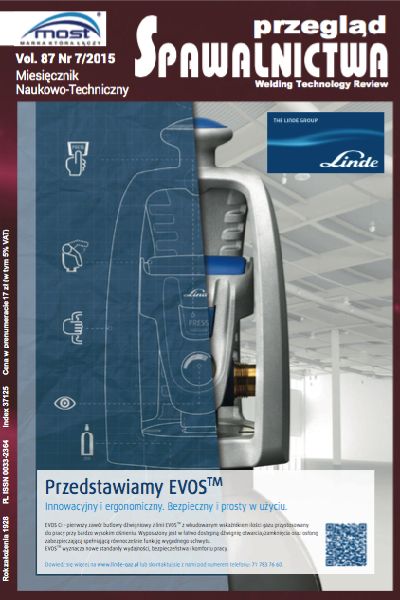Z historii cięcia termicznego
Main Article Content
Abstract
Cięcie termiczne jest jedną z najistotniejszych i najpowszechniej stosowanych technologii spawalniczych. Jego rozwój postępował wraz z ewolucją technologii spawania, poczynając od przełomu XIX i XX wieku. Jako pierwsze zastosowano w praktyce cięcie płomieniowe przez spalanie metalu z użyciem tlenu, a jako gazy palne stosowano wodór i acetylen. Inaczej niż technologie spawania, cięcie tlenowe niemal natychmiast zyskało uznanie i popularność. Znacznie wolniej rozwijało się cięcie łukowe. Dopiero zastosowanie cięcia łukowo-plazmowego doprowadziło do wzrostu praktycznego znaczenia tej grupy technologii. Po relatywnie długim okresie doskonalenia urządzeń i technologii ogromną popularność zdobyło cięcie laserowe, które intensywnie rozwija się do dziś.
History of thermal cutting
Thermal cutting is one of most important and popular welding technologies. Its development progressed in parallel to evolution of welding starting from last years of XIX th century. The fuel gas cutting by burning of metal in oxygen was introduced first and hydrogen and acetylene were used as the fuel gases. Different to pure welding the oxygen cutting was recognized very fast and became very popular. Much slower was progress in arc cutting. Only introduction of arc-plasma cutting has led to growth of practical role of this group of technologies. After relatively protracted period of polishing of equipment and technologies huge popularity was gained by laser cutting which still grows and develops very fast.
Downloads
Article Details
Creative Commons CC BY 4.0 https://creativecommons.org/licenses/by/4.0/
Welding Technology Review (WTR) articles are published open access under a CC BY licence (Creative Commons Attribution 4.0 International licence). The CC BY licence is the most open licence available and considered the industry 'gold standard' for open access; it is also preferred by many funders. This licence allows readers to copy and redistribute the material in any medium or format, and to alter, transform, or build upon the material, including for commercial use, providing the original author is credited.
References
Beckert M.: Aus der Geschichte des autogenen Brennschneidens. w: Schweissen und Schneiden 2001 nr 2.
Menne E.: Beseitigen von Ofenansätzen und dergl. bei Hochöfen und anderen Öfen oder zum Durchschmelzen hinderlicher Metallmassen vermittels eines Gebläses. Deutsches Reich Patent D.R.P. 137588. Berlin 1901.
Bernsdorf G.: Auf heissen Spuren vom Schmieden, Loten und Schweissen. VEB Fachbuchverlag. Leipzig 1986.
Verfahren und Vorrichtungen zum Schneiden von Metallgegenstan- den usw. unter Anwendung eines Lotrohrs und von Sauerstoff. Deutsches Reich Patent D.R.P. 216963. Berlin 1905.
Jansen H.: Brennschneiden unter Wasser. w: Schweissen und Schneiden 1962 nr 8.
Schimpke P. Die neueren Schweissverfahren. Springer-Verlag. Berlin Heidelberg 1926.
Bruenn E.: Brennschneiden und Trennen. VEB Verlag Technik Berlin 1954.
Porębski E.: Łączenie metali. Zgrzewanie, stapianie, lutowanie i przecinanie. Spółka Wydawnictw Technicznych. Lwów 1921.
Perun. Kalendarz Spawalniczy nr 5, Warszawa 1935.
Poradnik spawalniczy wyd.3. WNT Warszawa 1970.
Lipiński J.: Druga wojna światowa na morzu. Wyd. Morskie, Gdańsk 1976.
Coleman C. Electric metal-working apparatus. US Patent Office
A 1900.
Frous F. (red.) Poroskovaja metallurgia titanovych splavov. Izd. Metallurgia Moskva 1985.
Hull W.G.: Use of Gas-Shielded Arc processing for cutting of nonferrous metals, w: Welding and Metal Fabrication 1954 nr 5.
Almqvist E.: History of Industrial Gases. Kluver Academic/Plenum
Publishers. New York 2003.
Gage R. Arc Torch and Processes. US Patent 2806124A 1957.
Browning J. Electric Arc Torch US Patent 3139509A. 1964.
Couch R., Dean R. Plasma arc torch having liquid laminar flow jet for arc constriction. US Patent 3641308A 1972.
Brzozowski W., Mikoś M., Reda J., Wang R.: Palniki plazmowe do cięcia metali. w: Przegląd Spawalnictwa 1963 nr 10.
Czech J., Ozaist J.: Półautomat do cięcia plazmą typu ACa-500.
w: Biuletyn Informacyjny Instytutu Spawalnictwa 1964 nr 22.
Szczeciński Z.: Kronika Instytutu Spawalnictwa z lat 1945-96.
Wyd. Instytutu Spawalnictwa Gliwice 1998
Boehm S. Der Elektronenstrahl als Werkzeug fuer die Fuegentechnik. DVS Berichte Band 299. DVS Media GmbH, Duesseldorf 2014
Ardenne M. Bodo V. Device for producing filters. US Patent 2267714A.1941.
Steigerwald K-H. Drilling by electrons. US Patent 2793281A. 1957.
McNeil I. (ed.) An Encyclopaedia of the History of Technology.
Routledge 2002.
Lackner M. (ed.) Lasers in Chemistry vol.1. Wiley VCH Verlag GmbH,Weinhein 2008.
Hilton P. In the Begining... (the History of Laser Cutting). w: Papers of 21st International Congress of Applications of Lasers and Electro-Optics. Scottsdale, Arizona 2002.
Hansson R. The Rise of Fiber Laser Cutting. w: Biuletyn f-my Salvagini 2011.
Chrobak G. TruDisk nowoczesne lasery na ciele stałym do zastosowań spawalniczych. w: Spajanie 2011 nr 2.
